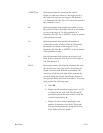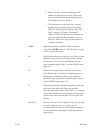Bar Codes5–100
Clear Zone
The bar code structure requires a completely blank clear zone which
extends 4.75 inches from the right edge of the mailpiece. In addition, a
minimum clear zone of 0.040–inch above and below the bar code data must
also be provided. Be sure to provide sufficient space for this zone.
Start/Stop Code
The start and stop codes are referred to as “framing bars” in POSTNET.
The start and stop codes are each one tall bar, one identifying the leading
and trailing end of the bar code. The start/stop code is automatically
produced with each bar code. The start/stop code structure permits bar code
scanning in a left–to right direction only.
Data Field
The bar code data produces a single field of 30 bars for a 5–digit field, 50
bars for a 9–digit data field, or 60 bars for an 11–digit data field. The bars
are grouped in sets of five. Each set of five bars (comprised of two tall bars
and three short bars) represents one of the five digits of the zip code, plus
the four–digit zip code extension. If the Advanced Bar Code is used, an
additional two–digit code is also added to make an 11–digit data field.
Each bar width is equal, and must be .020–inch
± .005–inch. Each bar
height is either a tall (full) or short (half) bar, representing a 1 or 0,
respectively. Each tall bar must be .125–inch
± .010–inch; each short bar
must be .050–inch
± .010–inch. Horizontal spacing between bars (pitch)
must be 22 bars
± 2 bars per inch over any 0.50–inch portion of the bar
code.
Horizontal spacing at 24 and 20 bars per inch is 0.0416–inch and
.050–inch, respectively, with a clear vertical space ranging from 0.012–inch
to 0.040–inch between bars.
Check Digit
The sixth, tenth or twelfth digit represents the automatic check digit
character for the 5, 9 or 11–digit data field, respectively. The check digit is
added automatically to verify accurate scanning.


















